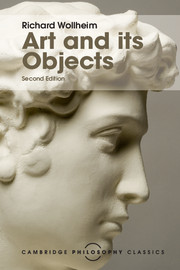Book contents
- Frontmatter
- Dedication
- Contents
- Preface to this edition
- Preface to the second edition
- The argument
- Art and its objects
- Supplementary essays
- 1 The Institutional theory of art
- 2 Are the criteria of identity for works of art aesthetically relevant?
- 3 A note on the physical object hypothesis
- 4 Criticism as retrieval
- 5 Seeing-as, seeing-in, and pictorial representation
- 6 Art and evaluation
- Bibliography
3 - A note on the physical object hypothesis
from Supplementary essays
Published online by Cambridge University Press: 05 November 2015
- Frontmatter
- Dedication
- Contents
- Preface to this edition
- Preface to the second edition
- The argument
- Art and its objects
- Supplementary essays
- 1 The Institutional theory of art
- 2 Are the criteria of identity for works of art aesthetically relevant?
- 3 A note on the physical object hypothesis
- 4 Criticism as retrieval
- 5 Seeing-as, seeing-in, and pictorial representation
- 6 Art and evaluation
- Bibliography
Summary
In the main body of the text I consider a theory which I there call the physical object hypothesis. This theory is to the effect that in those arts where the work of art is an individual, i.e. painting, carved sculpture, and, possibly (see Essay II), architecture, the work of art is a physical object, and, after some consideration given to the theory, I suspend judgment on its truth. My plea is the metaphysical complexity of the topic. I give no conclusive answer to the question whether in those arts the work of art is really identical with, or is merely constitutively identical with or made of the same stuff as, some physical object.
The likeliest, though not the sole, alternative to holding the physical object hypothesis is to posit, for each work of art in question, a further individual, or an ‘aesthetic object’ with which the work of art is then identified. Light is thrown on the physical object hypothesis by examining this alternative to it – let us call it ‘aesthetic object theory’ – and, in particular, by considering the two different ways in which such a theory may be motivated, which are in turn reflected in two different forms the theory may take. One motivation is familiar, and much discussed in contemporary aesthetics, but the other motivation is less clearly recognized though it is to my mind more compelling.
The first motivation comes from reflecting upon the physical painting, carved sculpture, or building quite timelessly. Such reflection reveals that the properties of the physical object may be divided into those which are, and those which are not, of aesthetic interest. An aesthetic object is then postulated alongside the physical object to be the bearer of all of the first but none of the second set of properties, and it is concluded to be the work of art.
A premiss to this argument is that a work of art has only aesthetic properties, it cannot have non-aesthetic properties, and the best way of considering this first version of aesthetic object theory is through considering this premiss. This premiss gives the motivation behind this version, which may be expressed as that of trying to safeguard the aesthetic character of the work of art.
- Type
- Chapter
- Information
- Art and its Objects , pp. 119 - 123Publisher: Cambridge University PressPrint publication year: 2015



